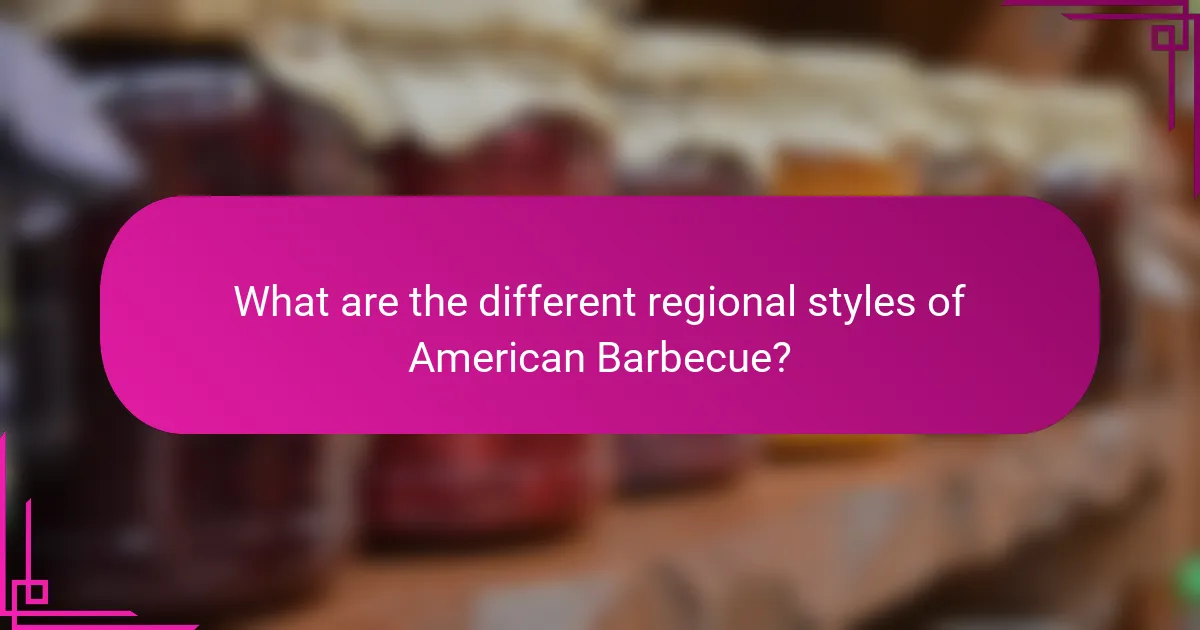American Barbecue is a slow-cooking method for meat that utilizes indirect heat and wood smoke for flavor, with distinct regional styles across the United States, including Texas, Kansas City, Memphis, and Carolina. Each style features specific meat cuts such as brisket, ribs, pulled pork, and sausage, along with unique sauces and cooking techniques. Key techniques for successful American Barbecue include smoking, grilling, and indirect cooking, which enhance the flavor and texture of the meat. This article provides an overview of the various regional styles, essential meat cuts, and cooking methods that define American Barbecue culture.

What is American Barbecue?
American Barbecue is a cooking method that involves slow-cooking meat over indirect heat, often using wood smoke for flavor. This technique typically includes various regional styles across the United States, such as Texas, Kansas City, and Memphis. Each style features unique meat cuts and sauces. For instance, Texas barbecue is known for its brisket, while Kansas City barbecue often includes a variety of meats with a thick, sweet sauce. The cooking process can take several hours, allowing for tender, flavorful results. American Barbecue has its roots in indigenous cooking methods and has evolved through cultural influences over centuries.
How did American Barbecue evolve over time?
American Barbecue evolved through various cultural influences and regional adaptations. Its origins trace back to indigenous cooking methods, where meats were slow-cooked over open flames. European settlers introduced their own techniques, blending them with local practices. In the 19th century, barbecue became a communal event, particularly in the Southern United States. The introduction of different meats, such as pork and beef, created regional styles. The use of specific wood types for smoking also varied by region, enhancing flavor. By the mid-20th century, barbecue gained national popularity, leading to the establishment of regional competitions and festivals. Today, American Barbecue reflects a diverse array of styles, influenced by cultural exchanges and innovations over time.
What historical influences shaped American Barbecue?
American Barbecue is shaped by various historical influences, including Native American, African, and European traditions. Native Americans introduced techniques like pit roasting and smoking meats. African slaves brought their culinary practices, including the use of spices and slow cooking methods. European settlers contributed their own grilling techniques and recipes, particularly from regions like England and Spain. The blending of these diverse influences led to the development of distinct regional barbecue styles. For example, Texas barbecue reflects cattle ranching heritage, while Carolina barbecue is influenced by vinegar-based sauces. Historical events, such as the introduction of barbecue festivals in the 19th century, further popularized these regional styles.
How have regional variations developed in American Barbecue?
Regional variations in American barbecue have developed due to cultural influences, geography, and available resources. Different regions emphasize specific meats and cooking methods. For example, Texas is known for its beef brisket, while North Carolina specializes in pulled pork. The use of different sauces also varies; mustard-based sauces are popular in South Carolina, whereas vinegar-based sauces dominate in Eastern North Carolina. Historical migration patterns influenced these styles, as settlers brought their culinary traditions. Local ingredients further shaped regional flavors, such as the use of pecan wood in Texas. Over time, barbecue competitions and festivals have helped to popularize and spread these diverse styles.
What are the key components of American Barbecue?
The key components of American Barbecue include meat, seasoning, cooking methods, and regional styles. Meat is typically the centerpiece, with popular choices being pork, beef, and chicken. Seasoning often consists of rubs or marinades, which enhance flavor. Cooking methods vary, including smoking, grilling, and slow-cooking. Regional styles influence the preparation and presentation, with notable variations found in Texas, Kansas City, and the Carolinas. Each region has unique techniques and sauces that define its barbecue culture. For example, Texas is known for its brisket, while Carolina barbecue often features pulled pork with vinegar-based sauces.
What types of meats are commonly used in American Barbecue?
Commonly used meats in American barbecue include pork, beef, chicken, and lamb. Pork is often featured as pulled pork or ribs. Beef is typically served as brisket or short ribs. Chicken is commonly barbecued whole or as pieces. Lamb is less frequent but can be found in some regional styles. These meats are chosen for their ability to absorb smoke and flavor during the cooking process. Barbecue techniques often enhance the tenderness and taste of these meats.
How do different cooking techniques impact the flavor of barbecue?
Different cooking techniques significantly impact the flavor of barbecue. Techniques such as smoking, grilling, and braising each impart unique flavors. Smoking introduces a deep, rich flavor through the use of wood chips. The type of wood, such as hickory or mesquite, further influences the taste. Grilling provides a charred, caramelized exterior that enhances sweetness. Direct heat from grilling creates a distinctive sear that adds complexity. Braising, on the other hand, tenderizes meat while infusing it with flavors from the cooking liquid. Each method also affects the meat’s texture, contributing to the overall flavor experience. The choice of technique thus plays a crucial role in defining barbecue’s taste profile.

What are the different regional styles of American Barbecue?
The different regional styles of American Barbecue include Texas, Kansas City, Memphis, and Carolina styles. Texas barbecue is known for its brisket and use of wood smoke. Kansas City barbecue features a variety of meats and a thick tomato-based sauce. Memphis barbecue is famous for its pulled pork and dry rubs. Carolina barbecue is characterized by its vinegar-based sauces and whole hog cooking. Each style reflects local traditions and preferences, showcasing the diversity of American barbecue culture.
How do the styles differ across the United States?
Barbecue styles differ significantly across the United States. Each region has its unique techniques, flavors, and preferred meats. For example, Texas barbecue is known for its beef brisket and use of dry rubs. In contrast, Carolina barbecue emphasizes pulled pork and vinegar-based sauces. Kansas City barbecue features a variety of meats, including ribs and burnt ends, often accompanied by a thick, sweet sauce. Memphis barbecue is famous for its dry-rubbed ribs and pulled pork sandwiches. The Pacific Northwest often incorporates salmon and other local fish into its barbecue. These regional differences highlight the diverse culinary traditions found throughout the country.
What defines Texas-style barbecue?
Texas-style barbecue is defined by its focus on beef, particularly brisket. The meat is typically smoked over post oak wood. This style emphasizes a dry rub of spices rather than marinades. Texas barbecue often features a distinct bark, created during the smoking process. It is served with minimal sauce, allowing the meat’s flavor to shine. Regional variations include Central Texas, known for its brisket, and East Texas, which often includes pork. The cooking method involves low and slow smoking, usually at temperatures around 225 to 250 degrees Fahrenheit. Texas barbecue has historical roots in cattle ranching, influencing its preference for beef cuts.
What are the characteristics of Kansas City-style barbecue?
Kansas City-style barbecue is known for its diverse range of meats and rich flavors. It typically includes pork, beef, chicken, and even sausage. The cooking method involves slow smoking over a variety of woods, often including hickory. A distinctive feature is the use of a thick, sweet, and tangy tomato-based sauce. This sauce is often applied during cooking and served on the side. Kansas City barbecue is characterized by its burnt ends, which are crispy, flavorful pieces of brisket. The region’s barbecue also emphasizes a balance of sweet, spicy, and smoky flavors. These characteristics have made Kansas City a prominent barbecue destination in the United States.
How does Carolina-style barbecue vary between regions?
Carolina-style barbecue varies significantly between regions, primarily between Eastern and Western North Carolina. Eastern Carolina barbecue typically features whole hog cooking and a vinegar-based sauce, which is thin and tangy. This style emphasizes the natural flavor of the pork, often with added spices. In contrast, Western Carolina barbecue, also known as Lexington-style, focuses on pork shoulder and uses a tomato-based sauce that is sweeter and thicker.
Additionally, the preparation methods differ. Eastern barbecue often involves cooking over hardwood coals, while Western barbecue may incorporate a smoker for enhanced flavor. Historical influences also play a role, with Eastern barbecue rooted in traditional Southern cooking, while Western barbecue reflects a blend of local tastes and preferences. The distinct sauces and cooking techniques create a clear regional identity within Carolina-style barbecue.
What unique attributes do these regional styles possess?
Regional styles of American barbecue possess distinct attributes that set them apart. Each style is characterized by its unique sauce, cooking method, and preferred meat cuts. For example, Texas barbecue primarily features beef brisket and often uses a dry rub. In contrast, Kansas City barbecue is known for its sweet and thick tomato-based sauce, commonly applied to a variety of meats, including ribs and pulled pork. Memphis barbecue emphasizes pork, particularly ribs and shoulders, often smoked and served with a tangy vinegar-based sauce. Carolina barbecue is distinguished by its use of whole hog and vinegar-based sauces, varying in style between Eastern and Western North Carolina. These regional differences reflect local tastes, traditions, and available ingredients, contributing to the rich diversity of American barbecue.
How do flavor profiles differ among regional barbecue styles?
Flavor profiles among regional barbecue styles differ significantly due to variations in sauces, spices, and cooking techniques. For instance, Kansas City barbecue is known for its sweet and tangy tomato-based sauces. In contrast, Texas barbecue often emphasizes dry rubs and smoke from post oak wood, highlighting the natural flavor of the meat.
North Carolina barbecue features vinegar-based sauces, which can be either Eastern style (whole hog) or Western style (shoulder), offering a sharp and tangy taste. Memphis barbecue is characterized by its dry ribs and use of a spice rub, with a focus on pork.
Each region’s unique ingredients and methods create distinct flavor experiences. The diversity in regional barbecue styles reflects local ingredients and cultural influences. This variation is supported by the historical context of barbecue development across the United States.
What are the traditional side dishes associated with each style?
Traditional side dishes vary by regional barbecue style in America. For Kansas City barbecue, baked beans and coleslaw are common. Texas barbecue often features potato salad and pickles. In Memphis, people enjoy coleslaw and potato chips. Carolina barbecue is typically served with hushpuppies and coleslaw. Each of these side dishes complements the distinct flavors of the meats served in their respective styles.

What are the essential meat cuts used in American Barbecue?
The essential meat cuts used in American barbecue include brisket, ribs, pulled pork, and sausage. Brisket is a popular cut from the chest of the cow. It is known for its rich flavor and tenderness when smoked properly. Ribs, particularly pork spare ribs and baby back ribs, are favored for their juicy meat and smoky taste. Pulled pork comes from the shoulder of the pig, which becomes tender and flavorful when cooked low and slow. Sausage, often made from pork or beef, adds a spicy and savory element to barbecue. These cuts are staples in various regional barbecue styles across the United States. Each cut has unique cooking techniques that enhance its flavor and texture.
What are the most popular cuts of meat for barbecue?
The most popular cuts of meat for barbecue include brisket, ribs, pulled pork, and chicken. Brisket is a flavorful cut from the breast of the cow, known for its tenderness when smoked. Pork ribs, especially baby back and spare ribs, are favored for their rich taste and texture. Pulled pork, made from the shoulder of the pig, is celebrated for its juiciness and ability to absorb flavors. Chicken, particularly thighs and wings, are also commonly grilled or smoked due to their versatility and flavor. These cuts are staples in American barbecue and are often highlighted in regional styles across the country.
How does the choice of cut affect cooking time and flavor?
The choice of cut significantly affects both cooking time and flavor. Different cuts of meat have varying levels of fat, connective tissue, and muscle fiber. For instance, tougher cuts like brisket require longer cooking times to break down collagen and become tender. In contrast, tender cuts such as filet mignon cook faster due to lower connective tissue content.
Flavor is also influenced by the cut. Fatty cuts tend to have richer flavors because fat enhances taste. For example, pork shoulder has a higher fat content, resulting in a juicier and more flavorful dish when slow-cooked. Lean cuts, like chicken breast, may require marinating or seasoning to enhance flavor, as they lack natural fat.
In summary, the cut of meat determines the cooking method, time, and overall flavor profile in barbecue.
What are the best practices for preparing different meat cuts?
The best practices for preparing different meat cuts include proper selection, seasoning, and cooking techniques. Selecting the right cut is crucial; for example, tougher cuts like brisket benefit from slow cooking. Seasoning should enhance the meat’s natural flavors; a simple rub of salt, pepper, and spices is often effective. Cooking methods vary; grilling works well for steaks, while smoking is ideal for larger cuts. Maintaining the correct temperature is essential; for beef, a medium-rare finish is typically around 135°F. Resting meat after cooking allows juices to redistribute, improving flavor and tenderness. These practices ensure optimal taste and texture in barbecue preparations.
How do different cuts contribute to the overall barbecue experience?
Different cuts of meat significantly influence the overall barbecue experience. Each cut has unique characteristics, affecting flavor, texture, and cooking methods. For example, brisket is known for its rich flavor and tenderness when slow-cooked. Ribs offer a balance of meat and fat, enhancing their juiciness and taste. Pork shoulder, often used for pulled pork, becomes incredibly tender after long cooking times. The marbling in cuts like ribeye adds depth to the flavor profile during grilling. Different regional styles emphasize various cuts, showcasing local preferences and traditions. For instance, Texas barbecue often highlights brisket, while Kansas City is famous for its ribs. These variations enhance the overall enjoyment and authenticity of the barbecue experience.
What are the best cooking techniques for each type of meat cut?
Grilling, smoking, braising, and roasting are the best cooking techniques for various meat cuts. Tender cuts like filet mignon benefit from grilling or pan-searing. These methods enhance flavor while keeping the meat juicy. For tougher cuts like brisket, smoking is ideal. This slow cooking method breaks down collagen, resulting in tender meat. Pork shoulder is best suited for braising or slow cooking. These techniques allow the meat to become flavorful and tender over time. Chicken thighs can be grilled or roasted to maintain moisture and flavor. Each technique complements the specific attributes of the meat cut, ensuring optimal taste and texture.
How does marbling influence the taste and texture of barbecue meat?
Marbling significantly enhances the taste and texture of barbecue meat. It refers to the intramuscular fat found within the meat. This fat melts during cooking, providing moisture and flavor. As a result, marbled meat tends to be juicier and more tender. Studies show that higher marbling scores correlate with improved taste satisfaction in consumers. For example, USDA grading systems classify beef based on marbling levels, impacting market value. Moreover, the presence of marbling can create a richer flavor profile, making the meat more enjoyable. Thus, marbling is crucial for achieving high-quality barbecue meat.

What cooking techniques are essential for successful American Barbecue?
Essential cooking techniques for successful American Barbecue include smoking, grilling, and indirect cooking. Smoking involves cooking meat at low temperatures over wood smoke for extended periods. This method infuses the meat with rich flavors and tenderness. Grilling is a quicker technique that uses direct heat to cook meat, often resulting in a seared exterior. Indirect cooking involves placing meat away from the heat source, allowing it to cook slowly and evenly. Each technique enhances the flavor and texture of the meat. Mastering these methods is crucial for achieving authentic American Barbecue results.
What are the primary cooking methods used in barbecue?
The primary cooking methods used in barbecue are smoking, grilling, and indirect heat cooking. Smoking involves cooking meat slowly over low heat with wood smoke for flavor. Grilling refers to cooking meat quickly over direct high heat, often on a grate. Indirect heat cooking, commonly used in barbecue, involves placing meat away from the heat source, allowing it to cook evenly. These methods are foundational in American barbecue traditions. Each method imparts distinct flavors and textures to the meat, contributing to the overall barbecue experience.
How does smoking differ from grilling in barbecue preparation?
Smoking uses low heat and indirect cooking for long periods. It infuses meat with flavor from wood smoke. Grilling employs high heat and direct cooking for shorter durations. This method sears meat quickly, creating a crust. Smoking typically involves larger cuts of meat, which benefit from slow cooking. Grilling is suited for smaller cuts, like burgers and steaks. The temperature in smoking can range from 200°F to 300°F. Grilling temperatures often exceed 400°F. Each method produces distinct flavors and textures in the final dish.
What role does marinading play in barbecue cooking techniques?
Marinading enhances flavor and tenderness in barbecue cooking techniques. It allows the meat to absorb spices and acids, resulting in a more flavorful dish. The process typically involves soaking the meat in a mixture of acidic ingredients, such as vinegar or citrus juice, along with herbs and spices. This acid breaks down protein structures, making the meat more tender.
Research indicates that marinades can penetrate meat up to 1/4 inch, influencing taste and texture. According to a study published in the Journal of Food Science, marinating chicken in a mixture of vinegar and spices improved overall flavor and juiciness. Marinading also helps to create a caramelized crust during cooking, enhancing the barbecue experience.
What are the common mistakes to avoid in barbecue cooking?
Common mistakes to avoid in barbecue cooking include cooking at too high a temperature. High heat can lead to burnt exteriors and undercooked interiors. Another mistake is not preheating the grill properly. Preheating ensures even cooking and better flavor. Failing to use a meat thermometer is also common. A thermometer helps achieve the correct internal temperature for safety and taste. Additionally, over-marinating can lead to mushy meat. Marinades should enhance flavor without compromising texture. Not allowing meat to rest after cooking is another mistake. Resting lets juices redistribute, improving tenderness. Lastly, neglecting to clean the grill can affect flavor and cooking performance. Regular cleaning prevents flare-ups and unwanted tastes.
How can temperature control impact the quality of barbecue?
Temperature control directly impacts the quality of barbecue by influencing the cooking process. Proper temperature ensures even cooking of meat, preventing undercooking or overcooking. Maintaining low and slow temperatures allows collagen in tougher cuts to break down, resulting in tender meat. High temperatures can lead to a charred exterior while leaving the inside raw. Optimal temperature also affects the development of flavors through the Maillard reaction, enhancing the overall taste. Studies show that cooking meat at a consistent temperature improves texture and juiciness. For example, brisket cooked at 225°F for 12-14 hours yields better results than at higher temperatures. Therefore, precise temperature management is crucial for achieving high-quality barbecue.
What tips can improve the overall barbecue experience?
To improve the overall barbecue experience, focus on preparation, technique, and environment. Start by selecting high-quality meat cuts. Fresh, well-marbled meat enhances flavor and tenderness. Marinating the meat beforehand adds moisture and depth. Use a dry rub or marinade that complements the meat’s natural flavors.
Control the cooking temperature carefully. Maintaining a consistent temperature is crucial for even cooking. Utilize indirect heat for larger cuts to prevent burning. Monitor internal temperatures with a meat thermometer for perfect doneness.
Create a comfortable atmosphere for guests. Provide ample seating and shade. Offer a variety of sides and beverages to complement the barbecue. Engage guests with interactive cooking or tasting experiences.
Finally, clean the grill before and after use. A clean grill prevents flare-ups and ensures better flavor. Following these tips can significantly enhance the barbecue experience.
American Barbecue is a cooking method characterized by slow-cooking meat over indirect heat, often enhanced with wood smoke. This article explores the evolution of American Barbecue, examining its historical influences, regional variations, and key components such as meat cuts, cooking techniques, and flavor profiles. It highlights distinct styles from regions like Texas, Kansas City, Memphis, and Carolina, detailing the unique attributes and traditional side dishes associated with each. Additionally, the article discusses best practices for preparing various meat cuts and the importance of temperature control in achieving optimal barbecue results.
